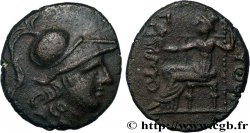v49_0143 - TRACIA - ISOLA DI TRACIA - SAMAOTRACIA Unité, (PB, Æ 18)
MONNAIES 49 (2011)
Начальная цена : 195.00 €
Назначить цену : 300.00 €
Цена реализации : 235.00 €
Количество ставок : 2
Максимальная предлагаемая цена : 268.00 €
Начальная цена : 195.00 €
Назначить цену : 300.00 €
Цена реализации : 235.00 €
Количество ставок : 2
Максимальная предлагаемая цена : 268.00 €
Тип Unité, (PB, Æ 18)
Дата: c. 200 AC.
Монетный двор / Город: Thrace, Samothrace
Металл: copper
Диаметр: 17,5 mm
Ориентация осей монеты: 3 h.
Вес: 5,09 g.
Редкость: R1
Комментарии о состоянии
Exemplaire sur un petit flan épais, bien centré des deux côtés, un peu court au revers sur les légendes. Très beau portrait d’Athéna. Revers de haut relief, bien venu à la frappe servi par une très jolie patine vert olive profond
Ссылки в каталоге: :
Происхождение:
Cet exemplaire provient du stock de Claude Silberstein (2003)
Лицевая сторона
Аверс: легенда: ANÉPIGRAPHE.
Аверс: описание: Buste d’Athéna (Minerve) casquée et drapée à droite, coiffée du casque corinthien.
Обратная сторона
Реверс: Описание: Cybèle (la Grande mère) tourélée, drapée assise à gauche, tenant une phiale (patère) de la main droite et un long sceptre de la main gauche.
Реверс: легенда: SA-M[O]/ PUQO[K]
Реверс: перевод: (Samos/ Pythok...).
Комментарий
Sur notre exemplaire la fin du nom du magistrat n’est pas visible comme sur de nombreux exemplaires. C’est la première fois que nous présentons une pièce de Samothrace.








 Cообщить об ошибке
Cообщить об ошибке Распечатать страницу
Распечатать страницу Отправить мой выбор
Отправить мой выбор Задать вопрос
Задать вопрос Consign / sell
Consign / sell
 Информация
Информация




